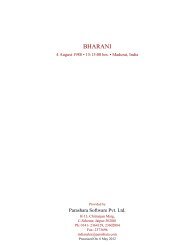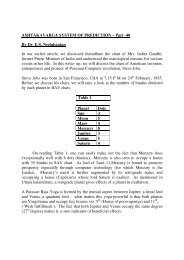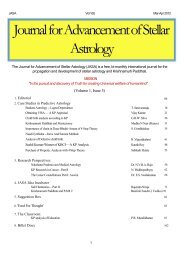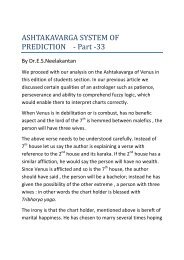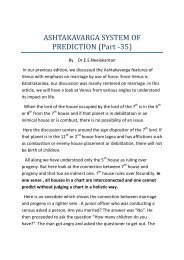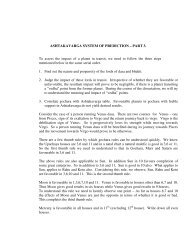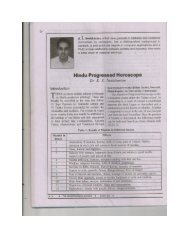Astrological significnce of junction points - Neelakantan
Astrological significnce of junction points - Neelakantan
Astrological significnce of junction points - Neelakantan
Create successful ePaper yourself
Turn your PDF publications into a flip-book with our unique Google optimized e-Paper software.
Introduction:<br />
ASTROLOGICAL SIGNIFICNCE OF JUNCTION POINTS<br />
By Dr. E.S. <strong>Neelakantan</strong>, FCA, Phd.<br />
A ”<strong>junction</strong>” as we understand in a general sense is a “point <strong>of</strong> intersection”. It<br />
can be precisely defined as “the place where two or more things come together .<br />
“We see this term frequently used in railways. A railway station which lies in<br />
between two cities in different directions is termed as a <strong>junction</strong>. Trains travel in<br />
the same direction until they reach this <strong>junction</strong> and then move in different<br />
directions towards their respective destinations. Trains leaving from Chennai<br />
towards Trivandrum and Mumbai travel till Arakkonam Junction in the same track<br />
but once they leave Arakkonam, the train which leaves for Mumbai proceeds on<br />
the track towards Renigunta while the one which leaves for Trivandrum proceeds<br />
towards Jolarpet. But railway stations which facilitate movement in one direction<br />
only are not called as “<strong>junction</strong>s”.<br />
In astrology these “<strong>junction</strong> <strong>points</strong>” assume enormous significance. In this article,<br />
we will try and discuss these “<strong>junction</strong> <strong>points</strong>” in detail. But initially we will focus<br />
our attention on a puranic story and learn its moral.<br />
STORY OF HIRANYA KASHIPU:<br />
The story <strong>of</strong> Hiranyakashipu is narrated In detail in Bhagavata Purana. Brahma’s<br />
mind-born (Manasaputras) sons, Sanaka,Sanandana, Sanatana and<br />
Sanatkumara appear to be mere children (even though they are very old in age)<br />
and when they visit the abode <strong>of</strong> Vishnu (Vaikuntha) they are stopped at the gate<br />
by the gatekeepers Jaya and Vijaya. The four boys curse Jaya and Vijaya to be<br />
born on earth, (thus losing their divinity) and live as human beings. Vishnu,<br />
knowing about the curse says that the curse cannot be lifted but gives two<br />
options – to take seven births as devotees <strong>of</strong> Vishnu or to take three births as<br />
Vishnu’s enemy. After serving either <strong>of</strong> these sentences, they will re-attain their<br />
original stature and unite with Vishnu permanently in Vaikuntha. The thought <strong>of</strong><br />
staying away from Vishnu for seven births appeared too long a period for Jaya<br />
and Vijaya (to remain separate from Vishnu )and they chose to exercise the<br />
second option. In the first life they were born as demons Hiranyaksha and<br />
Hiranyakashipu (in the second, they were Ravana and Kumbakarna and in the<br />
third Sishupala and Dantavakra).<br />
After obtaining a boon from Brahma Hiranyakashipu sought the gift <strong>of</strong> immortality<br />
which the former refused. As an alternate plea, Hiranyakashipu sought that he<br />
should not be killed at daytime or night, on the ground or in the sky, by a weapon,<br />
by a human being or an animal or by a demigod or a demon or by a great snake<br />
from lower planets. This boon was conferred by Brahma to Hiranyakashipu.
The form <strong>of</strong> Lord Narasimha was assumed by Vishnu to kill Hiranyakashipu<br />
without upsetting the boon given by Brahma.<br />
1. By killing him on the lap (which neither sky nor earth) in the threshold <strong>of</strong><br />
the building (which is neither indoor nor outdoors), the first condition<br />
stood satisfied.<br />
2. He was killed at Sandhya Kala (twilight) which is neither daytime nor night.<br />
3. The demon was killed using nails and therefore the condition that no<br />
weapons should be used stood satisfied.<br />
4. Narasimha was partly a man and partly a lion meaning that the killing was<br />
effected neither by a man nor by a beast.<br />
The inner significance <strong>of</strong> time is brought out by the fact that Vishnu chose to<br />
manifest as Narasimha - one <strong>of</strong> ten major incarnations – at twilight, a crucial<br />
“Junction Point” in astrology. The “Sandhya Kala” is considered a favourable<br />
time for meditation for those who seek union with divine.<br />
Hiranyaksha and Hiranyakashipu were born to Diti (daughter <strong>of</strong> Daksha<br />
Prajapati) and sage Kashyapa. It is said that the Asuras (demons) were to them<br />
as result <strong>of</strong> their union at the time <strong>of</strong> sunset, which is said to be inauspicious for<br />
performance <strong>of</strong> such art. This is another astrological principle which emerges out<br />
<strong>of</strong> this Puranic tale.The period around sunset should be earmarked solely for<br />
spiritual activities and because Sage Kashyapa failed to follow this dictum the<br />
demons were born.<br />
BRAHMA MUHURTHA:<br />
The word “Muhurtha” refers to a time interval lasting for about 48 minutes. A day<br />
has 1440 minutes (24hours x 60 minutes per hour). Dividing 1440 by 48, we get<br />
30 muhurthas in a day. The 29 th muhurtha which happens to be the penultimate<br />
<strong>of</strong> the 30 muhurthas falls about an hour before Sunrise and it is termed as<br />
“Brahma Muhurtha”. If Sunrise is exactly at 6 A.M., Brahma Muhurtha operates<br />
between 4.24 A.M. and 5.12 A.M. According to the Ayurvedic treatise “Ashtanga<br />
Hridhayam” one who is desirous <strong>of</strong> health and longevity should wake up during<br />
Brahma Muhurtha and perform his daily duties. It is the time which is highly<br />
conducive towards performance <strong>of</strong> spiritual activities. Visitors to Puttaparthi<br />
might as well recall that the chanting <strong>of</strong> “Omkar” in the Poornachandra<br />
Auditorium commences at around 4 A.M. and emphasis seems to have been laid<br />
by His Holiness Sai Baba for awakening the spiritual powers by having the daily<br />
schedule <strong>of</strong> his Ashram to commence at around the time Brahma Muhurtha<br />
operates. A table <strong>of</strong> Muhurthas (table 1) is given here for reference.
Table1<br />
No Time Name Quality<br />
1 06:00 – 06:48 Rudra Bad<br />
2 06:48 – 07:36 Ahi Bad<br />
3 07:36 – 08:24 Mitra Good<br />
4 08:24 – 09:12 Pitr Bad<br />
5 09:12 – 10:00 vasu Good<br />
6 10:00 – 10.48 varah Good<br />
7 10:48 – 11:36 Visvadeva Good<br />
8 11:36 – 12:24 Vidhi Good – except Monday & Friday<br />
9 12:24 – 13:12 Satamukhi Good<br />
10 13:12 – 14:00 Puruhuta Bad<br />
11 14:00 – 14:48 Vahini Bad<br />
12 14:48 – 15:36 Naktanakara Bad<br />
13 15:36 – 16:24 Varuna Good<br />
14 16:24 – 17:12 Aryama Good – except Sunday<br />
15 17:12 – 18:00 Bhaga Bad<br />
16 18:00 – 18:48 Girisa Bad<br />
17 18:48 – 19:36 Ajapada Bad<br />
18 19:36 – 20:24 Ahira<br />
Good<br />
Budhnya<br />
19 20:24 – 21:12 Pushya Good<br />
20 21:12 – 22:00 Asvini Good<br />
21 22:00 – 22:48 Yama Bad<br />
22 22:48 – 23:36 Agni Good<br />
23 23:36 – 24:24 Vidhat Good<br />
24 24:24 – 01:12 Kanda Good<br />
25 01:12 – 02:00 Aditi Good<br />
26 02:00 – 02:48 Jiva Good<br />
27 02:48 – 03:36 Vishnu Good<br />
28 03:36 – 04:24 Yumigadyuti Good<br />
29 04:24 - 05:12 Brahma Very good<br />
30 05:12 – 06:00 Samudram Good<br />
Abhijit Muhurtha:<br />
Just like <strong>junction</strong> point around Sunrise has the Brahma Muhurtha, the <strong>junction</strong><br />
point between fore-noon and after-noon gives rise to the Abhijit Muhurtha. Abhijit<br />
muhurtha starts 24 minutes before local noon time and 24 minutes thereafter. An<br />
example <strong>of</strong> how Abhijit Muhurtha operates is calculated is given as follows:<br />
Sun rise (estimated time) 7 AM<br />
Sun Set (estimated time) 6 PM<br />
Duration <strong>of</strong> day time = 11 hours = 11 x 60 = 660 minutes
Duration <strong>of</strong> each Muhurtha = 660/15 = 44 minutes<br />
Local Noon time = 7AM + 660/2<br />
= 7AM + 5 1/2 hours<br />
= 12.30 PM<br />
Abhijit Muhurtha = (12:30PM – 22 mts) to (12.30 PM+22 mts)<br />
= between 12.08 to 12.52 PM<br />
Abhijit muhurtha is also used as an “Emergency Muhurtha” – some times when<br />
auspicious days are not available and events have to happen at short-notice,<br />
then this Muhurtha is usually recommended.<br />
Godhuli Lagna:<br />
The period 12 minutes prior to Sunset and 12 minues after Sunset is trmed as<br />
Godhuli lagna and this period is considered to be extremely auspicious.<br />
Gandanthams:<br />
(a) Nakshatra Gandantham:<br />
The last two ghatikas <strong>of</strong> Ashlesha and the first two ghatikas <strong>of</strong> Makha<br />
constitutes Nakshtra Gandantham. So also Revathi – Aswini and Jyeshta<br />
– Moola give rise to gandanthams. (Please note that 1 ghatika = 24<br />
minutes)<br />
(b) Thithi Gandantham:<br />
The last two ghatikas <strong>of</strong> Panchami,Dasami, Full Moon and New Moon<br />
constitute Thithi Gandanthams.<br />
(c) The last navamsas <strong>of</strong> Cancer, Scorpio, Leo, and Saggittarius are Rasi<br />
Gandanthams.<br />
Nakshtra Gandanthams adversely affects the native, parents and brothers, while<br />
Rasi Gandanthams affects the family. Thithi Gandanthams affects parents.<br />
Solar Ingress:<br />
While “Gandantham” is based on lunar ingress, “Sankranthis” are based on solar<br />
ingress. The most important <strong>of</strong> them are the ingresses <strong>of</strong> Sun into Aries, Cancer,<br />
Libra and Capricorn. The solar ingress into Cancer is termed “Dakshinayana<br />
Punyakalam” while the ingress into Capricorn is celebrated as “Makara<br />
Sankranthi”. It is said that Japa, Homa or Charity done on these days fetches<br />
merit multiplied one crore times compared to a normal day.
We have heard <strong>of</strong> various lords such as lord <strong>of</strong> grain, lord <strong>of</strong> clouds, lord <strong>of</strong> paddy<br />
crops in the reading <strong>of</strong> almanacs undertaken at the time <strong>of</strong> Ugadi. All these<br />
portfolios are allocated to these planets on the basis <strong>of</strong> solar ingress into various<br />
signs.<br />
The planet which denotes the lord <strong>of</strong> the day on which sun enters into first point<br />
<strong>of</strong> Aries is the King <strong>of</strong> the year. The day-lord on the day <strong>of</strong> solar ingress into<br />
Taurus becomes Minister. The complete significations can be comprehended<br />
from table 2 as follows.<br />
Table 2<br />
Auspicious Deaths:<br />
Solar Ingress into sign Portfolio<br />
1) Aries King<br />
2) Taurus Minister<br />
3) Gemini Fluids<br />
4) Cancer Paddy Crops<br />
5) Libra Fruits & vegetables<br />
6) Sagittarius Corn<br />
7) Capricorn Mineral Kingdom<br />
Solar Ingress into Star Portfolio<br />
1) Ardra Regent <strong>of</strong> Clouds.<br />
In Hindu philosophy, Death is also considered as an auspicious occasion when a<br />
person merges with the divine. There is an adage, “Ekadashi Maranam,<br />
Dwadashi Dahanam” (Death on Ekadashi day and cremation on Dwadashi day).<br />
This is considered highly auspicious for the welfare <strong>of</strong> the departed soul.<br />
This is very rare but it would be beneficial to one and all if the phenomenon could<br />
be described elaborately here. According to Shastras, the corpse has to be<br />
cremated without time delay. So let us say a person departs on Monday (which<br />
has Ekadashi thithi for the full day), then it is not permitted by the Shastras to<br />
wait till Tuesday for cremation. Sometimes on a certain day Ekadashi may be<br />
there till, say, 10 AM. Assuming the person departs at 8 AM. Then the funeral<br />
rites are performed and by the time cremation starts (by say 11AM), Dwadashi<br />
thithi would be operating. This according to Shastras is highly auspicious as<br />
Ekadashi is a special day for worshiping Lord Vishnu. However it needs to be<br />
emphasized here that the time <strong>of</strong> death will depend mainly on poorva janma<br />
karma as well as merits <strong>of</strong> deeds committed in present birth.
BHAVA SANDHI AND DASA SANDHI:<br />
The effect <strong>of</strong> a planet in Bhava Sandhi is said to be Nil. Malefics in Bhava sandhi<br />
lose their power to do evil and benefics lose the power to do good. Let us take<br />
the case <strong>of</strong> a girl in whose horoscope Mars occupies the 30 th degree <strong>of</strong> Mithuna<br />
in the 7 th house. Now the evil attributable to Kuja dosha stands nullified as Mars<br />
is in Bhava Sandhi.<br />
“Dasa Sandhi” is a concept peculiar to horoscope matching. If the boy’s chart<br />
shows, that he ends Rahu dasa and commences Jupiter dasa in august 2009,<br />
and the girl’s chart shows a changeover from Sun dasa to Moon dasa in<br />
September 2009, then the two charts should not be matched. Between a boy’s<br />
chart and girl’s chart these dasa sandhis should not occur for both <strong>of</strong> them within<br />
a six-month interval. This is to ensure that simultaneously both do not run into<br />
adversities since it can also prove fatal. This example is intended to show that<br />
the period when a particular dasha ends and another commences is also a<br />
crucial <strong>junction</strong>. There are certain Homas like “ Rahu-Brihaspathi” Homam to<br />
ward <strong>of</strong>f the evil due to Dasa sandhi – the abovementioned Homam is done at<br />
the fag end <strong>of</strong> Rahu dasa.<br />
CONCLUSION:<br />
Among astrologers, there are many who have strong reservations about<br />
recommending girls born in Moola Nakshatra. As discussed earlier, the taboo<br />
associated with Moola nakshatra is mainly due to the “Gandantha” concept. The<br />
former Pontiff <strong>of</strong> Kanchi Mutt, fondly called as Paramacharya has exhorted all<br />
astrologers not to perpetrate this taboo because it was leading to a situation<br />
where lots <strong>of</strong> girls born in Ashlesha, Moola, Jyeshta and Visaka stars were<br />
remaining unmarried giving anxious moments to parents. The evil yoga called<br />
“Gandantham” stands nullified if Moon is in its own varga, in friendly sign or in<br />
con<strong>junction</strong> with benefics or aspected by benefics. Without assessing the<br />
various factors influencing the Moon, lots <strong>of</strong> doomsday predictions are being<br />
issued by Astrologers in a superficial manner and this was the reason for the<br />
Paramacharya’s advice to all astrologers in general.Further the taboo associated<br />
with “ Moola “ merely takes into account the asterism occupied by the moon and<br />
ignores the strength <strong>of</strong> the chart as a whole which is based on the positions <strong>of</strong> all<br />
the Nine planets.



